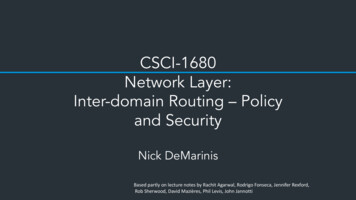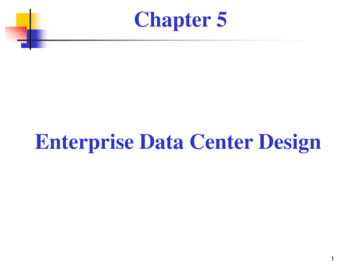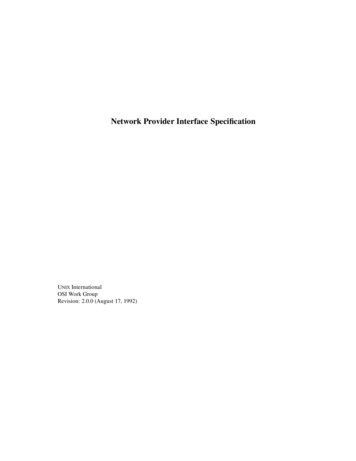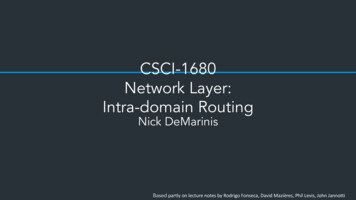
Transcription
CSCI-1680Network Layer:Inter-domain Routing – Policyand SecurityNick DeMarinisBased partly on lecture notes by Rachit Agarwal, Rodrigo Fonseca, Jennifer Rexford,Rob Sherwood, David Mazières, Phil Levis, John Jannotti
Warmup for discussionGiven this routing table, to whichprefix would a router map each IP? 8.5PrefixNext 138.16.100.0/24
AdministriviaUpcoming deadlines HW2: Out later today Next Thursday: HW2 due, Midterm out Next Friday: Midterm due IP deadline moved to Tuesday, March 22 Want to help rebuild this course? Apply to HTA/UTA in thefall!– Also looking for summer hires!
Today BGP Continued– Policy routing, instability, vulnerabilities
Longest Prefix MatchWhen performing a forwarding table lookup, select themost specific prefix that matches an addressPrefixNext Hop Eg. 12.34.18.51.0.0.0/8 12.34.0.0/16 12.34.16.0/20 138.16.0.0/16 138.16.100.0/24 Internet routers have specialized memory called TCAM (Ternary ContentAddressable Memory) to do longest prefix match fast (one clock cycle!)Goal: forward at line rate (as fast as link allows)
Prefixes Nodes in local network share prefix– Key to decide whether to send message locally Prefixes can also aggregate multiple networks– E.g., 100.20.33.128/25, 100.20.33.0/25 - 100.20.33.0/24 If networks connected hierarchically, can have significantaggregation But allocations aren’t so hierarchical what does thismean?
BGP Table GrowthSource: bgp.potaroo.net
BGP Table Growth for v6Source: bgp.potaroo.net
512k day On August 12, 2014, the full IPv4 BGP table reached512k prefixes Many older routers had only 512k of TCAM, had to fallback to slower routing methods Caused outages in Microsoft Azure, ebay, others
What can lead to table growth? More addresses being allocated Fragmentation– Multihoming– Change of ISPs– Address re-selling
Recall: BGP mechanics Path-vector protocol Exchange prefix reachability with neighbors (ASes)– E.g., “I can reach prefix 128.148.0.0/16 through ASes 444443356 14325 11078” Select routes to propagate to neighbors based onrouting policy, not shortest-path costs Today: Policies and implications
Where do we use policies?Policies are imposed in how routes are selected andexported Selection: which path to use in your network– Controls if/how traffic leaves the network Export: which path to advertise– Controls how/if traffic enters the network
BGP Update ProcessingUpdate processingOpen ended programming.Constrained only by vendor configuration languageControl planeBGPUpdates Apply ImportPoliciesBest RouteSelectionBGPUpdatesBest RouteTableApply ExportPoliciesData planeDatapacketsforwardingEntriesIP Forwarding TableDatapacketsImage credit Rachit Agarwal
AS RelationshipsXBZACYPolicies are defined by relationships between Ases Provider Customer PeersExample from Kurose and Ross, 5th Ed
AS relationships Customer pays provider for connectivity– E.g. Brown contracts with OSHEAN– Customer is stub, provider is a transit Many customers are multi-homed– E.g., OSHEAN connects to Level3, Cogent Typical policies:– Provider tells all neighbors how to reach customer– Provider wants to send traffic to customers ( )– Customer does not provide transit service
Peer Relationships Peer ASs agree to exchange traffic for free– Penalties/Renegotiate if imbalance Tier 1 ISPs have no default route: all peer with eachother You are Tier i 1 if you have a default route to a Tier i Typical policies– AS only exports customer routes to peer– AS exports a peer’s routes only to its customers– Goal: avoid being transit when no gain
Typical route selection policyIn decreasing priority order:1. Make or save money (send to customer peer provider)2. Try to maximize performance (smallest AS path length)3. Minimize use of my network bandwidth (“hot potatorouting”4.
Gao-Rexford Model (simplified) Two types of relationships: peers andcustomer/provider Export rules:– Customer route may be exported to all neighbors– Peer or provider route is only exported to customers Preference rules:– Prefer routes through customer ( ) If all ASes follow this, shown to lead to stable network
Typical Export PolicyDestination prefixadvertised by Export route to CustomerPeerEveryone (providers, peers,other customers )Customers onlyProviderCustomers onlyKnown as Gao-Rexford principles: define commonpractices for AS relationships
AS RelationshipsXBZACY How to prevent X from forwarding transit between B and C? How to avoid transit between CBA ?– B: BAZ - X– B: BAZ - C ? ( Y: CBAZ and Y:CAZ)Example from Kurose and Ross, 5th Ed
Peering Drama Cogent vs. Level3 were peers In 2003, Level3 decided to start charging Cogent Cogent said no Internet partition: Cogent’s customers couldn’t get toLevel3’s customers and vice-versa– Other ISPs were affected as well Took 3 weeks to reach an undisclosed agreement
BGP can be fragile Individual router configurations and policy can affectwhole network Consequences sometimes disastrous
Some BGP Challenges Convergence Traffic engineering– How to assure certain routes are selected Misconfiguration SecurityBGP can be fragile! One router configuration can affect alarge portion of the network
Recent Notable incidents October 4 2021: Facebook accidentally removed routesfor its DNS servers– Outside world couldn’t resolve facebook.com, and neither couldFacebook! June 24, 2019: Misconfigured router accepted lots oftransit traffic
“Shutting off” the Internet Starting from Jan 27th, 2011, Egypt was disconnected fromthe Internet– 2769/2903 networks withdrawn from BGP (95%)!Source: RIPEStat - http://stat.ripe.net/egypt/
Egypt IncidentSource: BGPMon (http://bgpmon.net/blog/?p 480)
BGP Security Goals Confidential message exchange between neighbors Validity of routing information– Origin, Path, Policy Correspondence to the data path
Origin: IP Address Ownership and Hijacking IP address block assignment– Regional Internet Registries (ARIN, RIPE, APNIC)– Internet Service Providers Proper origination of a prefix into BGP– By the AS who owns the prefix– or, by its upstream provider(s) in its behalf However, what’s to stop someone else?– Prefix hijacking: another AS originates the prefix– BGP does not verify that the AS is authorized– Registries of prefix ownership are inaccurate29
Prefix Hijacking43527112.34.0.0/16 Consequences for the affected ASes612.34.0.0/16– Blackhole: data traffic is discarded– Snooping: data traffic is inspected, and then redirected– Impersonation: data traffic is sent to bogus destinations30
Hijacking is Hard to Debug Real origin AS doesn’t see the problem– Picks its own route– Might not even learn the bogus route May not cause loss of connectivity– E.g., if the bogus AS snoops and redirects– may only cause performance degradation Or, loss of connectivity is isolated– E.g., only for sources in parts of the Internet Diagnosing prefix hijacking– Analyzing updates from many vantage points– Launching traceroute from many vantage points31
Sub-Prefix Hijacking43527112.34.158.0/24612.34.0.0/16 Originating a more-specific prefix– Every AS picks the bogus route for that prefix– Traffic follows the longest matching prefix32
How to Hijack a Prefix The hijacking AS has– Router with eBGP session(s)– Configured to originate the prefix Getting access to the router– Network operator makes configuration mistake– Disgruntled operator launches an attack– Outsider breaks into the router and reconfigures Getting other ASes to believe bogus route– Neighbor ASes not filtering the routes– e.g., by allowing only expected prefixes– But, specifying filters on peering links is hard33
Pakistan Youtube incident Youtube’s has prefix 208.65.152.0/22 Pakistan’s government order Youtube blocked Pakistan Telecom (AS 17557) announces 208.65.153.0/24in the wrong direction (outwards!) Longest prefix match caused worldwide outage http://www.youtube.com/watch?v IzLPKuAOe50
Many other incidents Spammers steal unused IP space to hide– Announce very short prefixes (e.g., /8). Why?– For a short amount of time China incident, April 8th 2010––––China Telecom’s AS23724 generally announces 40 prefixesOn April 8th, announced 37,000 prefixesAbout 10% leaked outside of ChinaSuddenly, going to www.dell.com might have you routingthrough AS23724!
Attacks on BGP Paths Remove an AS from the path– E.g., 701 3715 88 - 701 88 Why?––––Attract sources that would normally avoid AS 3715Make path through you look more attractiveMake AS 88 look like it is closer to the coreCan fool loop detection! May be hard to tell whether this is a lie– 88 could indeed connect directly to 701!
Attacks on BGP Paths Adding ASes to the path– E.g., 701 88 - 701 3715 88 Why?– Trigger loop detection in AS 3715 This would block unwanted traffic from AS 3715!– Make your AS look more connected Who can tell this is a lie?– AS 3715 could, if it could see the route– AS 88 could, but would it really care?
Attacks on BGP Paths Adding ASes at the end of the path– E.g., 701 88 into 701 88 3 Why?– Evade detection for a bogus route (if added AS is legitimateowner of a prefix) Hard to tell that the path is bogus!70118.0.0.0/888318.0.0.0/8
Proposed Solution: S-BGP Based on a public key infrastructure Address attestations– Claims the right to originate a prefix– Signed and distributed out of band– Checked through delegation chain from ICANN Route attestations– Attribute in BGP update message– Signed by each AS as route along path S-BGP can avoid– Prefix hijacking– Addition, removal, or reordering of intermediate ASes
S-BGP Deployment Very challenging–––––PKI (RPKI)Accurate address registriesNeed to perform cryptographic operations on all path operationsFlag day almost impossibleIncremental deployment offers little incentive But there is hope! [Goldberg et al, 2011]– Road to incremental deployment– Change rules to break ties for secure paths– If a few top Tier-1 ISPs Plus their respective stub clients deploy simplified version (just sign, not validate) Gains in traffic adoption!
Data Plane Attacks Routers/ASes can advertise one route, but not necessarily follow it!May drop packets Can send packets in a different direction– Or a fraction of packets– What if you just slow down some traffic?– Impersonation attack– Snooping attack How to detect? Harder to pull off, as you need control of a router– Congestion or an attack?– Can let ping/traceroute packets go through– End-to-end checks?
BGP Recap Key protocol that holds Internet routing togetherPath Vector Protocol among Autonomous SystemsPolicy, feasibility first; non-optimal routesImportant security problems
Next Class Network layer wrap up
Following slides not covered,but interesting
Convergence Given a change, how long until the network re-stabilizes?– Depends on change: sometimes never– Open research problem: “tweak and pray”– Distributed setting is challenging Some reasons for change––––Topology changesBGP session failuresChanges in policyConflicts between policies can cause oscillation
Routing Change: Before and After00(2,0)(2,0)(1,0)121(1,2,0)2(3,2,0)(3,1,0)33
Routing Change: Path Exploration AS 1– Delete the route (1,0)– Switch to next route(1,2,0)– Send route (1,2,0) toAS 3 AS 3– Sees (1,2,0) replace(1,0)– Compares to route(2,0)– Switches to using AS 20(2,0)1(1,2,0)2(3,2,0)3
Routing Change: Path Exploration Initial situation When destination dies – Destination 0 is alive– All ASes use direct path– All ASes lose direct path– All switch to longer paths– Eventually withdrawnE.g., AS 2–––– (2,0) à (2,1,0)(2,1,0) à (2,3,0)(2,3,0) à (2,1,3,0)(2,1,3,0) à nullConvergence may 3,0)1203(3,0)(3,1,0)(3,2,0)49
Route Engineering Route filteringSetting weightsMore specific routes: longest prefixAS prepending: “477 477 477 477”More of an art than science
Unstable Configurations Due to policy conflicts (Dispute Wheel)221020401301013203033
Avoiding BGP Instabilities Detecting conflicting policies– Centralized: NP-Complete problem!– Distributed: open research problem– Requires too much cooperation Detecting oscillations– Monitoring for repetitive BGP messages Restricted routing policies and topologies– Some topologies / policies proven to be safe** Gao & Rexford, “Stable Internet Routingwithout Global Coordination”, IEEE/ACM ToN, 2001
Scaling iBGP: route reflectorsiBGP Mesh O(n 2) messAS 1
Scaling iBGP: route reflectorsSolution: Route ReflectorsO(n*k)AS 1
Multiple Stable ConfigurationsBGP Wedgies [RFC 4264] Typical policy:– Prefer routes from customers– Then prefer shortest paths
BGP Wedgies345134234514515121.2.0.0/16: 1 1 1 1(Backup Path)511.2.0.0/16: 1Primary Path
BGP Wedgies321111342111143211115432111121.2.0.0/16: 1 1 1 1(Backup Path)511.2.0.0/16: 1Primary Path
BGP Wedgies3 prefers customer route: stable configuration!32111134 451211115121.2.0.0/16: 1 1 1 1(Backup Path)511.2.0.0/16: 1Primary Path
Origin: IP Address Ownership and Hijacking IP address block assignment -Regional Internet Registries (ARIN, RIPE, APNIC) -Internet Service Providers Proper origination of a prefix into BGP










